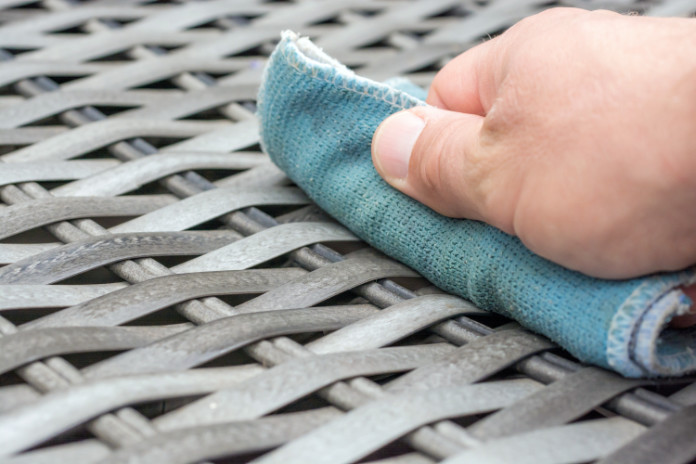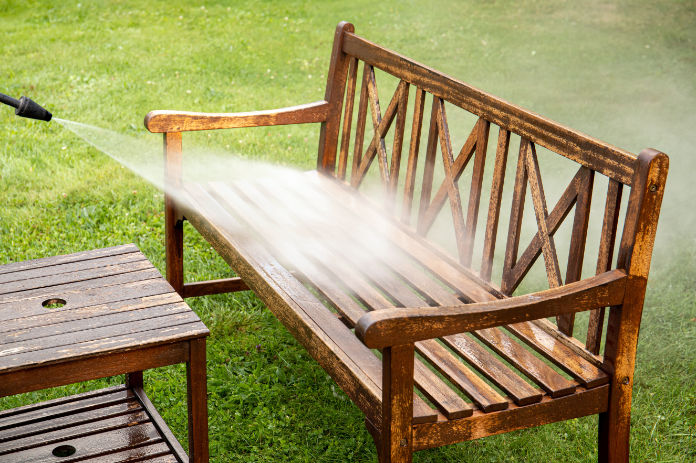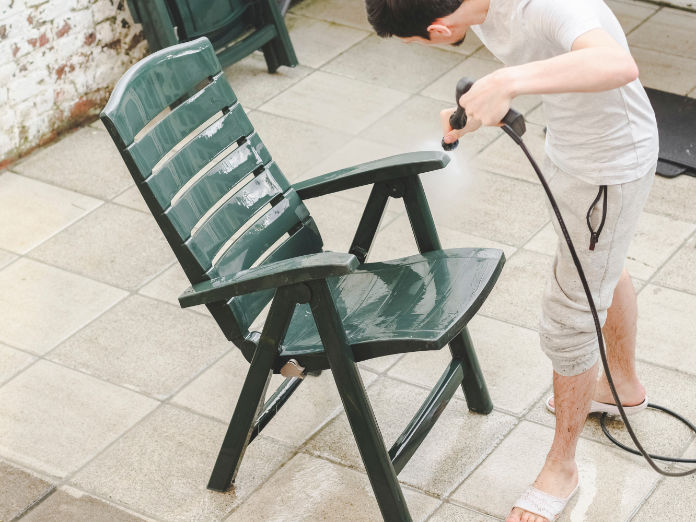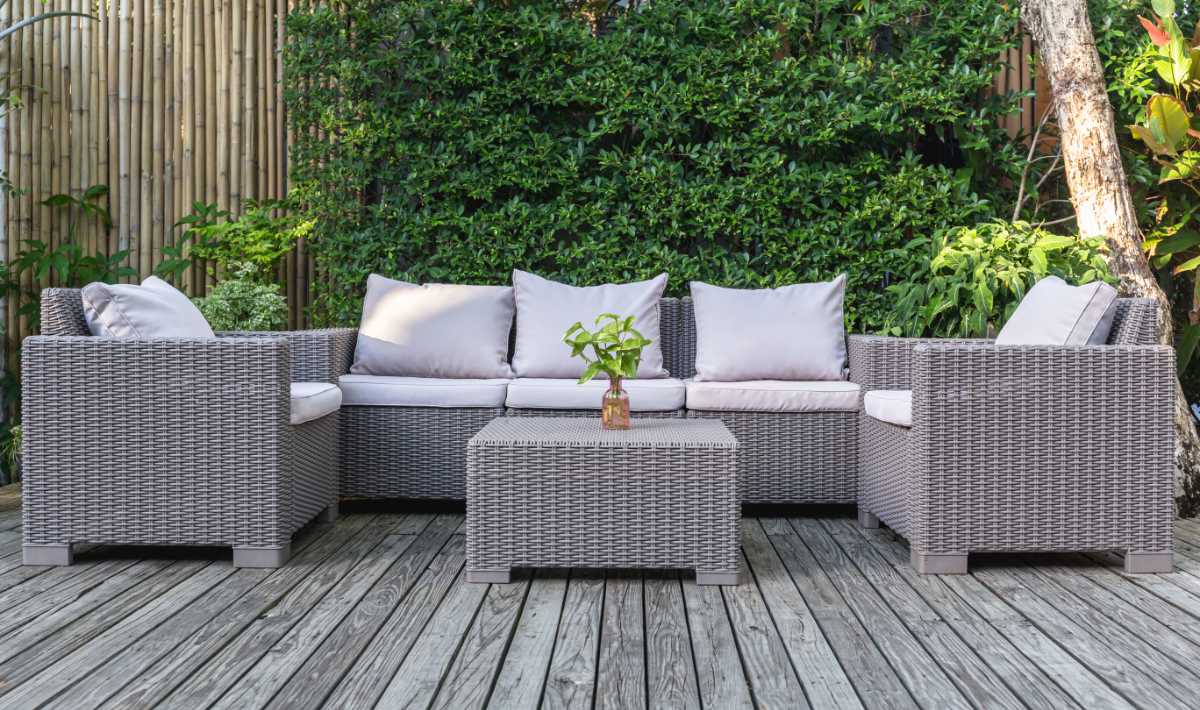Winter is fast approaching. With record-breaking rain nearly every year and plummeting temperatures, storing your garden furniture during winter is not just about maintaining its aesthetic appeal; it’s a practical step to ensure longevity and sustained value.
Even when labelled weather-resistant, outdoor furniture can suffer from prolonged exposure to cold temperatures, moisture, and snow. These elements can lead to fading, warping, rust, and structural damage. Furthermore, the weight of accumulated snow on seating or tables can strain the furniture and reduce its lifespan.
Storing your furniture during the chillier months keeps it in prime condition. It can save you money in the long run, preventing the need for early replacements or repairs. So, as winter approaches, give your outdoor pieces the care they deserve, and you’ll be greeted with garden furniture ready for use when warmer days return.
Clean your garden furniture before putting it in storage
Cleaning your garden furniture before putting it in storage is a must. Removing dirt, debris, and mould can ensure you have a fresh start in spring. Here are some ways to clean each type of furniture before storing it:
Wicker furniture: With its intricate weave and design, cleaning wicker furniture can be particularly tricky. Begin by gently brushing or vacuuming the surface to remove loose dust and debris, ensuring you target the crevices and undersides. Next, clean down the furniture using soap and a sponge. Once cleaned, rinse the furniture with a cloth dampened with plain water, then dry it thoroughly using a soft towel or let it air dry, ideally outdoors. If you struggle with hard-to-reach or stubborn stains, a soft-bristled toothbrush can be great for close up precision.

Wooden furniture: Begin by dusting the surface with a soft, lint-free cloth to remove any superficial dirt or debris. Prepare a mixture of lukewarm water and a few drops of mild dish soap for a deeper clean. Dampen a cloth with the solution, wringing it out thoroughly to prevent over-wetting the wood. Gently wipe the furniture’s surface, following the grain pattern to avoid scratches or damage. For any persistent stains or sticky spots, a mix of equal parts vinegar and water can be lightly applied, but always test on an inconspicuous area first. After cleaning, wiping down the wood with a dry cloth is essential to remove any residual moisture, as prolonged wetness can damage the finish or cause warping.

Plastic furniture: Start by brushing off any loose dirt or surface debris. Combine warm water and dish soap for a thorough clean. Using a sponge and the solution, gently scrub the plastic surfaces, paying extra attention to areas with scuff marks or stubborn stains. For more challenging spots, a mix of baking soda and water can create a gentle abrasive paste; apply this mix with a soft brush in circular motions. Once the cleaning is complete, rinse the furniture with clean water using a cloth or a garden hose.

Best-selling garden furniture cleaning solutions
Stuck for inspiration? Check out our list of best-selling Amazon products!
No products found.
How to choose the right type of storage for your garden furniture
It is essential to store your garden furniture in a dry and secure place. However, some types of garden furniture require specific storage conditions to ensure its longevity and protection.
Wicker furniture: A protective cover is an excellent start to storage for this garden furniture. An effective cover, such as a PVC sheet, can be an invaluable tool to shield wicker furniture from heavy rain and snow, which can result in structural water damage. For the strongest protection, try to move your wicker furniture into indoor storage during the harsh winter months. While some wicker garden furniture, such as synthetic rattan, can weather the winter conditions, it is always best to keep it indoors, in storage such as sheds or garages, to prolong its lifespan.
Wooden furniture: Depending on the type of wood, it is important to apply a protective layer of sealant or oil before storing. This helps to guard against potential moisture damage caused by the heavy rain during winter. When selecting a storage location, choose a dry, cool, and well-ventilated space, such as a garage or shed. If indoor storage isn’t feasible, invest in high-quality, water-resistant covers that are tailored for wooden garden pieces. Ensure the covers are secured tightly, yet allow for adequate airflow to deter mould. Properly stored, your wooden garden furniture will remain robust and ready for enjoyment in the coming seasons.

Plastic furniture: Putting plastic garden furniture in storage, while seemingly straightforward, benefits greatly from a few precautionary measures to maintain its pristine condition. First and foremost, thoroughly clean your furniture, wiping it down with a mixture of mild detergent and water. Ensure it is fully dry to prevent mould or mildew growth during storage.
When selecting a storage spot, aim for a shaded, cool area, as prolonged exposure to direct sunlight can lead to fading or brittleness in certain plastics. Consider stacking chairs or nesting tables to maximise storage efficiency if you have limited indoor space, like a shed or garage. Again, if indoor storage isn’t an option, invest in weather-resistant covers specifically designed for outdoor garden furniture. Secure the covers to prevent wind from lifting them, but ensure some ventilation to prevent condensation buildup.
Best-selling garden furniture waterproof covers
Stuck for inspiration? Check out our list of best-selling Amazon products!
No products found.
Tips for garden furniture storage
Here is some extra advice for storing garden furniture:
- Air flow: Air flow is paramount for the longevity of your outdoor garden furniture in storage. Proper airflow can deter the growth of mould, and help remove the build-up of bad smells of must and dust.
- Avoid grassy areas: If you had to leave your wicker and wood furniture outdoors during winter, try to avoid placing them on top of grass. Grass attracts unwanted moisture that can cause water damage.
- Storage units: It can be hard to find adequate storage for your garden furniture at home. That is why using storage units may be an effective way to provide suitable protection.
You may be interested in…
This article may include affiliate links to products and services where we may receive a small fee to support the running of this site if you make a purchase or is a sponsored article from one of our select editorial partners providing valuable advice and information to our readers.































































